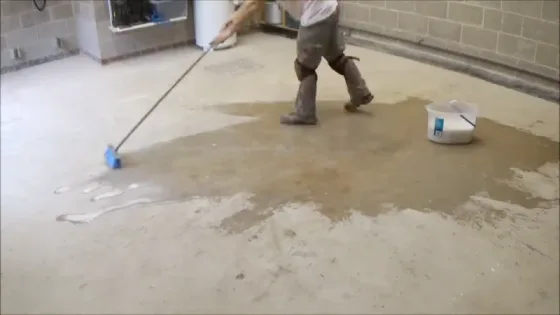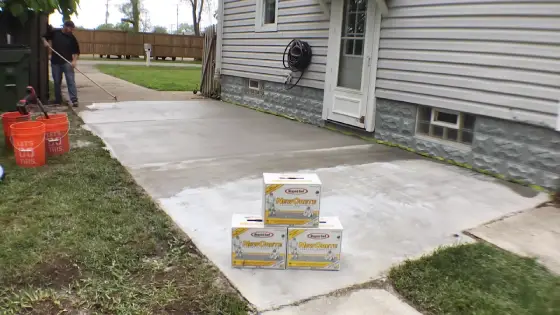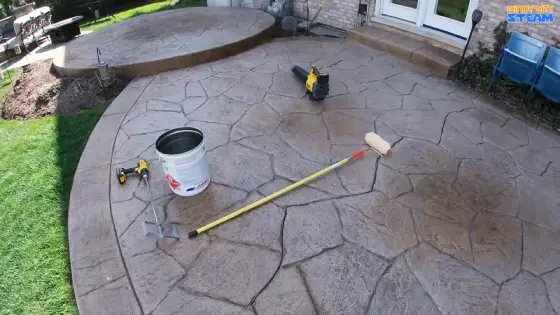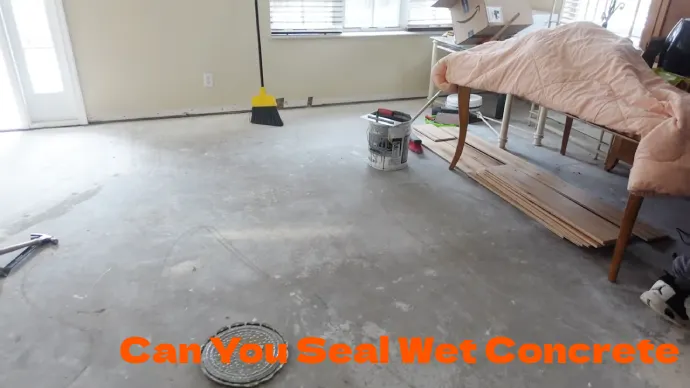Sealing concrete is an essential process that is necessary to protect it from harsh weather conditions, damages, and staining. However, the question of whether to seal wet concrete remains a common concern among homeowners and contractors.
It may seem like a straightforward question, but sealing wet concrete is not a recommended practice. Several issues arise from sealing wet concrete such as bubbling, discoloration, poor appearance, reduced sealant effectiveness, and potential damage to the concrete surface.
Knowing when to seal concrete for optimal protection and prolonged life is crucial. Check out the following look into the ramifications of sealing damp concrete which provides comprehensive guidance on when and how to seal your concrete projects.
Here, we will provide homeowners and contractors with the information they need to make informed decisions about sealing their concrete surfaces.
What Are the Consequences of Sealing Wet Concrete?

The sealing of wet concrete can result in various consequences that affect the overall quality of the surface. Here are some of them:
- Bubbling, Discoloration, and Poor Appearance
- Reduced Effectiveness of Sealant
- Potential Damage to Concrete Surface
- Potential Issues with Under Application and Overapplication
- Trapped Moisture
- Impaired Drying
1# Bubbling, Discoloration, and Poor Appearance
When wet concrete is sealed, it can develop bubbling, discoloration, and poor appearance. This happens because water gets trapped under the sealant and tries to escape through it. The moisture in the concrete reacts with the sealant, causing it to form bubbles and expand.
As more moisture tries to escape, it can cause discoloration and an uneven appearance of the concrete surface. The presence of water in the concrete is a critical factor to consider before sealing it. If the concrete is not entirely dry, any water trapped underneath the sealant can lead to various problems.
Therefore, allowing concrete to dry completely is recommended.
2# Reduced Effectiveness of Sealant
Trapped moisture in wet concrete can lessen the sealant’s effectiveness, causing it to crack and peel off. When this occurs, the sealant can no longer protect the concrete from dirt, impurities, and water, leading to further damage over time.
To prevent this, it is important to thoroughly dry the concrete before applying the sealant. Checking the moisture levels with a tool like a moisture meter is recommended. Waiting at least 28 days after pouring the concrete is also advised for proper curing.
3# Potential Damage to Concrete Surface
When new concrete is sealed prematurely, it can lead to damage to its appearance and structural integrity. If moisture and air are trapped under the sealant, the curing process can become uneven, resulting in cracks and rough patches on the surface.
A chemical reaction between water and cement takes place to cure concrete, which hardens the material. Sealing wet concrete too soon can slow or halt this process, preventing it from reaching full strength. This weakness can cause cracks and other damage in the future.
The best course of action is to wait for the concrete to cure entirely before applying any sealant.
4# Potential Issues with Under Application and Overapplication
Applying the sealer incorrectly can result in an uneven and problematic finish, with streaks and peeling appearing on the surface of the concrete. The concrete surface may not be adequately protected if the sealer fails to adhere properly, making it susceptible to water, chemicals, and UV damage.
On the other hand, overapplication can also cause issues, such as an uneven and blotchy finish, which can be difficult to repair. To avoid these issues, applying the sealer correctly, using the recommended amount and following the manufacturer’s instructions is important.
Before applying the sealer, make sure the concrete surface is clean and dry, as any moisture or debris can affect the bonding. Additionally, it is recommended to do a test patch or small area before applying the sealer to the entire surface to ensure it is applied correctly and evenly.
5# Trapped Moisture
When a sealer is applied to wet concrete, the outgassing from the concrete surface is hindered, trapping moisture beneath the sealer. This trapped moisture can cause blushing, where the concrete sealer appears whitened due to the presence of water beneath it.
Blushing occurs when moisture is trapped within the concrete and the sealer is unable to allow it to escape. This can result from sealing wet concrete or applying too much sealer.
To prevent blushing, ensure the concrete surface is completely dry before applying the sealer, and apply it thinly and evenly. Proper surface preparation, including cleaning and etching the concrete surface, can also help to prevent blushing.
6# Impaired Drying
As a result of moisture in concrete or the environment, water-based sealers can experience impaired drying. This occurs because water-based sealers need the water to evaporate from the sealer to cure properly.
High humidity and low temperatures can exacerbate impaired drying by slowing the evaporation process and causing extended curing times. This can lead to delays in construction or renovation work and weaken the sealer’s durability.
Therefore, it’s important to ensure the concrete and surrounding environment are as dry as possible before applying water-based sealers.
How do you know when concrete is ready to seal?

To determine if the concrete is ready to be sealed, one reliable method is testing its compressive strength using a non-destructive compression test. This involves applying pressure to the concrete cube until it fails and recording the force needed.
When the strength reaches around 2500 psi, the concrete is cured enough to be sealed. Additionally, the surface hardness of the concrete can be tested using the Brinell, Vicker’s Diamond, or Rockwell tests, which involve creating an indentation and measuring the force required.
However, compressive strength testing is the most commonly used and reliable method. Ensure concrete is completely cured before sealing to avoid issues. Testing the strength can help prevent problems with adhesion and durability.
What happens if it rains while concrete is being sealed?
If rain or moisture falls on concrete during sealing, it can lead to unsightly blemishes that will detract from the surface’s aesthetic appeal. Trapped moisture can cause discoloration and cloudiness as the sealant dries.
Even small amounts of dew or mist can cause issues, making it crucial to ensure the surface is completely dry before beginning. Sealing during wet weather also compromises the sealant’s effectiveness, leading to potential cracks or damage over time.
It’s essential to avoid sealing if rain, fog, or moisture is present to guarantee the surface is adequately protected.
What is the best time to seal the concrete after it rains?
When sealing concrete after rain, waiting until the weather is dry is important. The humidity should be less than 65% and the sealer requires a cure time of 12-24 hours before it can be exposed to moisture. Therefore, avoid fog or dew during this time.
Waiting at least 24 hours after rainfall before sealing is recommended to ensure ample time for the concrete to dry and cure. However, the drying time may vary depending on the climate. Always test the concrete’s moisture level before proceeding with the sealing process.
Can concrete be sealed at a certain temperature?
To achieve optimal results when applying a concrete sealer, the temperature range should be between 50 to 90 degrees Fahrenheit. This range allows the sealer to penetrate the concrete surface, resulting in a strong bond that can withstand chemicals, abrasion, and wear.
Applying concrete sealer in temperatures outside of this range may cause inadequate curing, poor adhesion and shorten the lifespan of the sealer. If the concrete sealer is applied in colder temperatures, it can take longer to dry and cure, resulting in a weaker bond and a less durable surface.
Conversely, sealing in hotter temperatures can cause the sealer to dry too quickly, resulting in a thin, uneven coating that may crack or peel over time.
Stick to the manufacturer’s recommendations and wait until the right temperature range before applying a concrete sealer. As a result, the sealer will form a strong bond with the concrete surface, ensuring that it lasts for a long time and effectively protects it.
How long should you stay off concrete during the sealing process?

After applying a sealer to the concrete, avoiding foot or vehicle traffic and any exposure to water or precipitation for at least 36-48 hours is important. This lets the sealer properly cure and form a strong, durable bond with the concrete.
If the concrete is disturbed before the sealer has fully cured, it can cause it not to bond correctly, leading to damage like flaking and peeling. The recommended time to stay off the concrete can vary depending on factors like the type of sealer used, temperature, and humidity levels.
Higher temperatures and humidity can speed up the curing process, while cooler temperatures and lower humidity can slow it down. Follow the manufacturer’s instructions when deciding how long to stay off the concrete after sealing.
Is it possible to apply concrete sealer at night?
If the temperature and humidity are appropriate, you can apply concrete sealer at night. It’s best to apply the sealer when the temperatures are decreasing, the sunlight is reduced, and the concrete has had time to cool down from sunlight exposure.
This usually happens during the late afternoon or evening. However, ensure the surface is dry and moisture-free before applying the sealer because water can interfere with the sealer’s effectiveness.
Avoid Sealing Wet Concrete to Prevent Multiple Problems
Sealing wet concrete results in problems like trapped moisture, discoloration, and poor adhesion. It’s vital to wait for the concrete to dry entirely before sealing it. A moisture meter can help determine whether the concrete surface is ready to be sealed. Wait until it reaches a moisture content of 4% or less.
Too soon sealing weakens the bond between the surface and the sealer. If it starts raining while sealing, stop and wait for the concrete to dry completely. Consider weather conditions before starting the sealing process. Wait at least 24 hours after a rainy day to seal concrete.
The recommended temperature range for sealing concrete is between 50-90°F. So, wait for the ideal conditions before you begin to seal your concrete. This will ensure that you get the best results without any issues.
